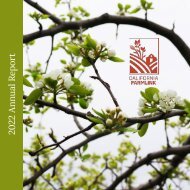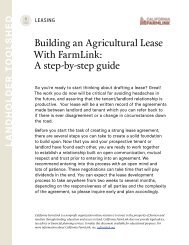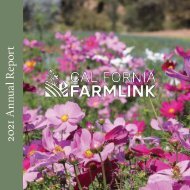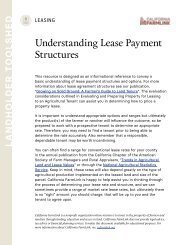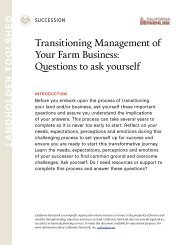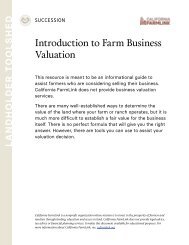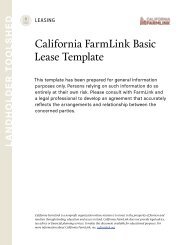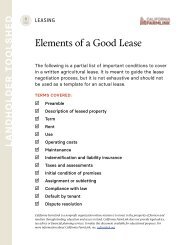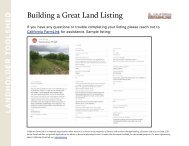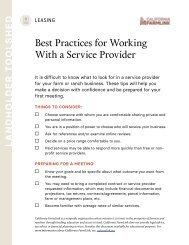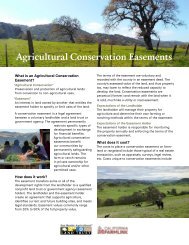Guide to Regenerative Grazing Leases: Opportunities for Resilience
California FarmLink and TomKat Ranch Educational Foundation teamed up to create this resource focused on land leases that support regenerative grazing practices. This guidebook aims to empower private, nonprofit, and public landholders, as well as easement-holders and grazing tenants.
California FarmLink and TomKat Ranch Educational Foundation teamed up to create this resource focused on land leases that support regenerative grazing practices. This guidebook aims to empower private, nonprofit, and public landholders, as well as easement-holders and grazing tenants.
Create successful ePaper yourself
Turn your PDF publications into a flip-book with our unique Google optimized e-Paper software.
CHAPTER 2. <strong>Grazing</strong> <strong>Leases</strong> (Continued)<br />
TERM<br />
The term of a lease defines the initial duration of the agreement, as well as any<br />
conditions <strong>for</strong> renewal. While lives<strong>to</strong>ck graziers can manage with annual or even<br />
monthly leases <strong>to</strong> meet immediate needs, such short-term agreements create<br />
uncertainty, discourage long-term investments and transitional practices, and increase<br />
the chance that graziers operate without a strong understanding of their context or<br />
commitment <strong>to</strong> improve the environment within which they are working. Medium- (3<br />
<strong>to</strong> 10 years) and long-term (11 <strong>to</strong> 51 years, in Cali<strong>for</strong>nia) tenure encourages lessee<br />
investment in infrastructure and business, as well as in regenerative management<br />
practices that build soil, conserve wildlife, and foster healthy grasslands.<br />
In instances where a lessee and landholder are new <strong>to</strong> working <strong>to</strong>gether, or when<br />
grazing needs are seasonally limited, a short-term or ‘trial’ lease may be mutually<br />
desirable. When the future ownership or use of the Property is uncertain, it may<br />
also be necessary <strong>to</strong> work under a shorter term lease. At the other end of the termlength<br />
spectrum, a ground lease can convey highly secure, long-term tenure, allowing<br />
the lessee <strong>to</strong> own and earn financial equity in ranch buildings, infrastructure, and<br />
potentially even equity in ecosystem improvements.<br />
Should permanent infrastructure be required, and investment of that infrastructure<br />
falls <strong>to</strong> the lessee, the duration of the term must be at least the length of the usable<br />
life of the improvement, and/or account <strong>for</strong> a buy-back of the remaining value of the<br />
investment at termination. For more detail, see Maintenance and Improvements.<br />
Many conservation incentive and cost-share programs have minimum lease<br />
term requirements. For example, Natural Resource Conservation Service (NRCS)<br />
Environmental Quality Incentives Program (EQIP) will reimburse lessees <strong>for</strong> practices<br />
and improvements including cross fencing so long as their lease is at least as long as<br />
the term of the NRCS contract (often 3-5 years).<br />
A lease may include a term renewal clause—either requiring the signatures of both<br />
parties or renewing au<strong>to</strong>matically <strong>to</strong> easily extend the term. ‘Rolling’ and ‘Evergreen’<br />
leases au<strong>to</strong>matically renew unless terminated. This can remove the headache and cost<br />
of frequent renegotiating, and encourage commitment on both sides, but beware it<br />
doesn’t also create a false sense of confidence. Short-term rolling leases are still only<br />
as secure as the length of their initial term, because they can be terminated by either<br />
party within a specified written notice period. If a short-term lease is a must, then<br />
consider a short-term lease with an au<strong>to</strong>matic longer-term extension if predetermined<br />
targets are met and the lessee remains in good standing. This model provides the<br />
lessee with an incentive <strong>to</strong> invest in regenerative land stewardship, while offering the<br />
landholder flexibility should they find the lessee is not a good match during the trial<br />
term.<br />
© Copyright 2022 Cali<strong>for</strong>nia FarmLink and TomKat Ranch Educational Foundation<br />
18



